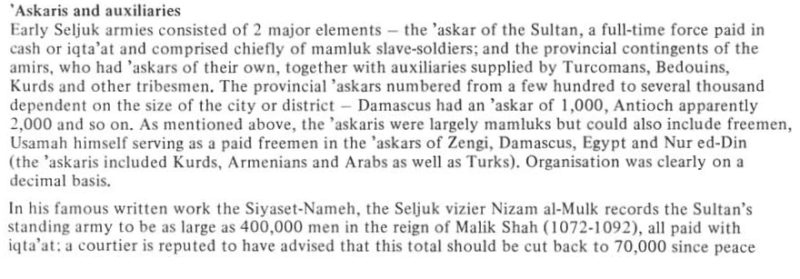Sahran said:
I'm not sure if you should start out with the Askar as the beginning of the infantry. I've almost always heard the term used to define the professional cavalrymen, rather than infantrymen. You can see on the page 18 of the Armies and Enemies of the Crusades book how it seems to really specifically focus on cavalry. Again when it goes to troops 35 through 38, whom "The figures themselves are probably syrians, representing the Turkish mamluks of the various askars". And given their professional nature, I don't understand why they should upgrade into the Ahdath (who are City militia) given it would go from professional to unprofessional.
#44 talks about the Syrian infantry, who are "provided largely by the city militias and other irregular volunteers (thus not the askaris)". The only Turks in this period who really were big proponents of Infantry were the Eastern Khorasan based dynasties (Ghaznavids/Ghorids). I believe in the West the guys who used the closest things to regular, well trained heavy infantry amongst the Seljuk states were the Zengids - I don't really think Rum did. Units #49 and #50 of the aformentioned book are cited as the Seljuk Infantry, "usually unarmored and most were either javelinmen or archers, and some crossbows". Personally I would recommend they replace the Askari at the bottom of the infantry roster and maybe even cut out the top tier of infantry, make various heavy/professional infantry available as mercenaries for the Seljuks of Rum based on Georgian/Byzantine/Syrian mercenaries.
No offense meant of course, just some research ideas.
Oh, none taken at all Sahran. This is actually good because this discussion probably means that we will end up with a troop tree thats even closer to being historically valid. Thanks for your input.
Now for my reply =p
The fact that Askars were
just cavalry is a misconception. Askars were mostly cavalry yes, because seljuk armies only used infantry as a form of foot archers or shock troops with their Mercenary shock troops such as Bedouin Nobles and Ghazi's being more effective at it. However, the same source we are discussing clearly states that the term Askar wasn't just for the Sultan's own slave mamluk force. He said that amirs or high ranked Iqta'dars also had their own Askaris who were sometimes composed of 'Freemen'.
Also, the way the Syrian infantry will be built is quite different than the Seljuk system because I do not think the system of Iqta'at had been implemented there yet. I think Saladin implemented it when he took the whole area much later, but look me up on that one.
Also, these infantry units are very light armored. I might not have specified that in the unit description so my bad, but these final tier spearmen are very basic Light Infantry and shock troops nothing more really.
In the end of the day, when you look at the Merc and Special units list you'd see that the Rums do not actually have access to any heavy infantry unit per say because they did not use them in the conventional style. Their infantry had to be light to match the flow of the rest of army.
Here is my support =p
As a 400 000 or even 70 000 army composing of pure Askaris of the Sultan, suggesting that they were all elite Ghulams and Mamluks is quite suspicious.
Perhaps what I can do is change the Askar basic name, since it esuggests a more professional troop, into an Ahdath Freeman, or Ahdath Recruit.
Lope de Rojas said:
Looks promising... if you need help with the Iberic Peninsula just ask me (as you did

)
But there is something wrong, or at least I think so: in the Bedouin trooptree, there is a three way upgrade (tribesman to raider, noble or archer), as far as I know it can be only a two way upgrade.
Btw, Outlawed, I'll pm you maybe in Monday or so, because this weekend I'm in a medieval fair in Ávila with my girlfriend, and I'm not going to use any pc in those days (not because of the fair, but to disconnect a little).
Glad to hear that you're joining us. I'll make an edit on first post when you PM me to see how exactly we are going to merge. Regarding the Bedouin troop tree, I'll see what I can do.
Edit: I did some research on the Muslim factions we have left out here. Most of them had mainly 1 province/area or main town and its fiefs. The two main ones that seem to have had a direct impact on the rest of the factions in the biggest way due to alliances/treaties/areas were the Ortuqids, or Artuqids and the Burids.
For me, the Burids of Damascus are a must. Since they held Damascus against the Crusaders and managed to get them to break the siege in 4 days. Some say they bribed their old allies, but we cannot know for sure. The Burids later became Vassals of the Zengids under Nur Al-Deen.
As for the Artuqids allied with Edessa against the Zengis. In 1144 when Edessa was taken they became vassals of the Zengids under Nur Al-Deen's father, Imad Al-Deen aka Zengi. They were also good allies to Salahudin against the Rum Sultanate.
So while adding the Artuqids is debatable mainly due to them being under the Zengids, we could add them.
Personally I think it will not have a good cost/benifit ratio but I want to hear what the rest of you think.

 )
)













